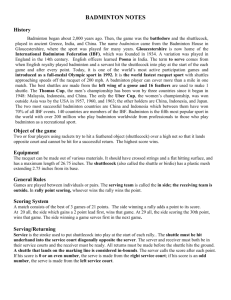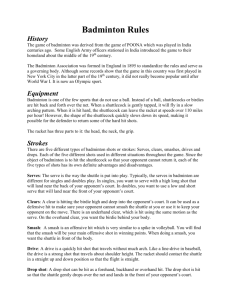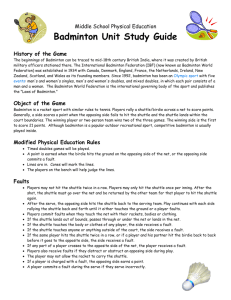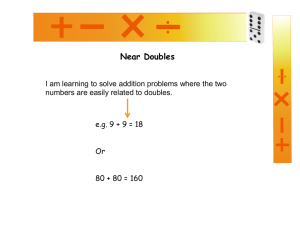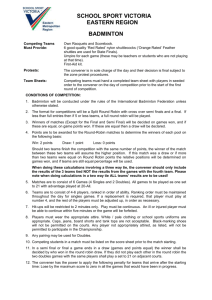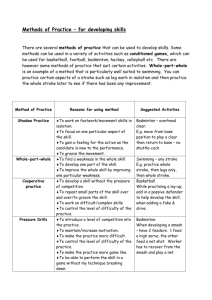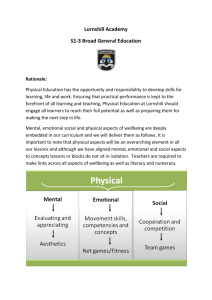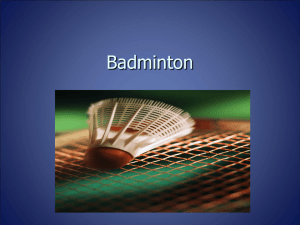Badminton - SkyView Academy
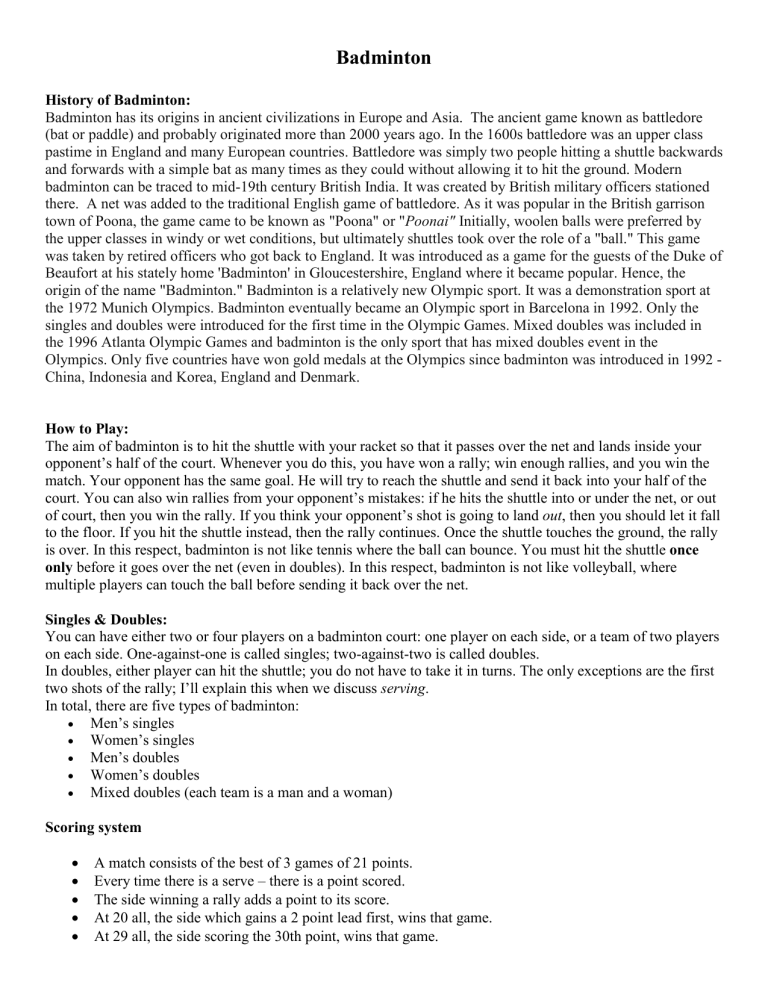
Badminton
History of Badminton:
Badminton has its origins in ancient civilizations in Europe and Asia. The ancient game known as battledore
(bat or paddle) and probably originated more than 2000 years ago. In the 1600s battledore was an upper class pastime in England and many European countries. Battledore was simply two people hitting a shuttle backwards and forwards with a simple bat as many times as they could without allowing it to hit the ground. Modern badminton can be traced to mid-19th century British India. It was created by British military officers stationed there. A net was added to the traditional English game of battledore. As it was popular in the British garrison town of Poona, the game came to be known as "Poona" or " Poonai" Initially, woolen balls were preferred by the upper classes in windy or wet conditions, but ultimately shuttles took over the role of a "ball." This game was taken by retired officers who got back to England. It was introduced as a game for the guests of the Duke of
Beaufort at his stately home 'Badminton' in Gloucestershire, England where it became popular. Hence, the origin of the name "Badminton." Badminton is a relatively new Olympic sport. It was a demonstration sport at the 1972 Munich Olympics. Badminton eventually became an Olympic sport in Barcelona in 1992. Only the singles and doubles were introduced for the first time in the Olympic Games. Mixed doubles was included in the 1996 Atlanta Olympic Games and badminton is the only sport that has mixed doubles event in the
Olympics. Only five countries have won gold medals at the Olympics since badminton was introduced in 1992 -
China, Indonesia and Korea, England and Denmark.
How to Play:
The aim of badminton is to hit the shuttle with your racket so that it passes over the net and lands inside your opponent’s half of the court. Whenever you do this, you have won a rally; win enough rallies, and you win the match. Your opponent has the same goal. He will try to reach the shuttle and send it back into your half of the court. You can also win rallies from your opponent’s mistakes: if he hits the shuttle into or under the net, or out of court, then you win the rally. If you think your opponent’s shot is going to land out , then you should let it fall to the floor. If you hit the shuttle instead, then the rally continues. Once the shuttle touches the ground, the rally is over. In this respect, badminton is not like tennis where the ball can bounce. You must hit the shuttle once only before it goes over the net (even in doubles). In this respect, badminton is not like volleyball, where multiple players can touch the ball before sending it back over the net.
Singles & Doubles:
You can have either two or four players on a badminton court: one player on each side, or a team of two players on each side. One-against-one is called singles; two-against-two is called doubles.
In doubles, either player can hit the shuttle; you do not have to take it in turns. The only exceptions are the first two shots of the rally; I’ll explain this when we discuss serving .
In total, there are five types of badminton:
Men’s singles
Women’s singles
Men’s doubles
Women’s doubles
Mixed doubles (each team is a man and a woman)
Scoring system
A match consists of the best of 3 games of 21 points.
Every time there is a serve – there is a point scored.
The side winning a rally adds a point to its score.
At 20 all, the side which gains a 2 point lead first, wins that game.
At 29 all, the side scoring the 30th point, wins that game.
The side winning a game serves first in the next game.
For PE we will play one game to 21 going no high than 30 points.
How to serve
In badminton, the serve must be hit in an upwards direction, with an underarm hitting action. You are not allowed to play a tennis style serve. The main rule here is that when you hit the shuttle, it must be below your waist. To be exact, the rules define this to be a height level with the lowest part of your ribcage. In other words, you can serve from a bit higher than the top of your shorts, but not much.
Serving and receiving courts
You shall serve from, and receive in, the right service court when you or your opponent has scored an even number of points in that game. You shall serve from, and receive in, the left service court when you or your opponent has scored an odd number of points in that game. You and your opponent will hit the shuttle alternately until a 'fault' is made or the shuttle ceases to be in play. Must go diagonal from you, and has to land in between the short service line and the long service line.
Scoring and serving
You score a point and serve again from the alternate service court when your opponent makes a 'fault' or the shuttle ceases to be in play because it touches the surface of your opponent's side of court. If the server earns a point they stay serving and switch sides.
Rules of Badminton - Doubles
At the start of the game, and each time a side gains the right to serve, the service shall be delivered from the right service court. Only your opponent standing diagonally opposite of you shall return the service. Should your opponent's partner touched or hit the shuttle, it shall be a 'fault' and your side scores a point.
Grips
ForehandLike a handshake, used for serving and forehand shot. The stroke used to return a ball hit to the right of a right-handed player and to the left of a left-handed player.
Back handRotate wrist to the right, the stroke used to return balls hit to the left of a right-handed player and to the right of a left-handed player.
The court
Doubles Service line
Short service line
Center line
Left service court
Right service court
Net
Doubles Sideline
Serves/Shots
Under hand
Forehand or backhand can be used, but the forehand is more common. Must serve from below your waist.
Forehand shots
Clear : A shot hit deep into the opponent's court.
Drop shot : A shot hit softly and with finesse to fall rapidly and close to the net in the opponent's court.
Smash : A hard-hit overhead shot that forces the shuttle sharply downwards into the opponent's court.
Back hand shots
Clear : A shot hit deep into the opponent's court.
Drop shot : A shot hit softly and with finesse to fall rapidly and close to the net in the opponent's court.
